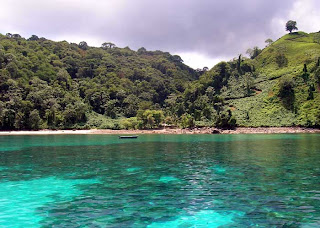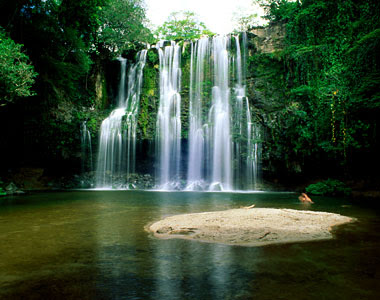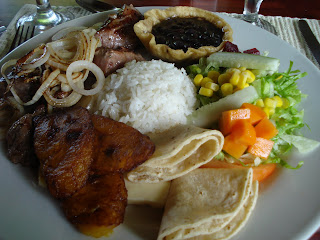 |
| Costa Rica Cities |
Costa Rica is filled with picturesque cities & towns like Sarchi where you will find pretty handicrafts, Arenal famous for its active volcano, Alajuela home of the Poas Volcano, & Puerto Viejo de Limon known for its laid-back Caribbean atmosphere.
Soon on this web page you will find information about different Costa Rica cities & towns in case you need information about a specific place let us know they will be over glad to assist you with any information you may need.
San José:
 |
| San José Costa Rica |
San José is the capital of Costa Rica. It is located in the central part of the country, and borders (clockwise beginning in the north) the provinces of Alajuela, Heredia, Limón, Cartago and Puntarenas. The provincial capital is San José. The province covers an area of 4,965.9 km². and has a population of 1,404,242.
San José has plenty of attractive theatres, plenty of with European-inspired architecture. These buildings serve as the city's main tourist attractions; not only because of the architectural beauty, but because of the numerous cultural, musical, & artistic presentations & activities, which include traditional & modern Costa Rican & San José culture.
The most well-known are:
- The National Theatre of Costa Rica (Teatro Nacional de Costa Rica).
- The Melico Salazar Theatre (Teatro Popular Melico Salazar).
- The National Auditorium of The Children's Museum of Costa Rica (Museo de los Niños).
- The National Theatre (Teatro Nacional de Costa Rica) and the Melico Salazar Theatre present drama, dance performances and concerts throughout the year. Nevertheless, other 'smaller' theatres can be found throughout the city and provide a large array of entertainment.
Teatro Variedades is San José's oldest theatre.
 |
| San-José-Costa-Rica1 |
San José is home to many parks and squares (plazas in Spanish); where one can find gazebos, open green areas, recreational areas, lakes, fountains, statues and sculptures by Costa Rican artists and many different bird, tree and plant species.
Some of the main Parks are:
- The National Park (Parque Nacional)
- Morazán Park; where you can find the Temple of Music (Templo de la Música)
- San José Central Park (Parque Central)
- La Sabana Metropolitan Park (Parque Metropolitano La Sabana)
- Peace Park (Parque de la Paz)
- Parque Okayama, which contains Japanese inspired architecture, artificial lakes, and sculptures.
San José's largest park and perhaps the city's most iconic is La Sabana Metropolitan Park. It is located in the western part of the city, in the district of 'Mata Redonda'.
Plazas, or squares, are very prominent in San José. La Plaza de La Cultura, literally 'Culture Square', is one example.
Simón Bolivar Zoo is the city's only zoological institution, and includes a large variety of species of animals and plants, both national and international.
Cartago:
 |
| Cartago Costa Rica |
Cartago is a city in Costa Rica, about 25 km (16 mi) east of the capital, San José. It is at an elevation of about 1435 m (some 4,707 ft) above sea level, at the base of the Irazú Volcano. Cartago is the capital of Cartago province. The city covers an area of 152,68 km². It includes the districts of city downtown: Oriental, Occidental (known as the typical downtown area), San Nicolás (the main entrance to the city, at west), El Carmen (north), Dulce Nombre, San Francisco (at south, San Francisco is known commonly as Aguacaliente), and Guadalupe (Arenilla). The city is part, with the cities of San Rafael de Oreamuno and Tejar del Guarco, of a continuous urban area that, in 2008, had a population of 156,600 inhabitants, according to the Statistics and Census Institute of Costa Rica.
Dominical:
 |
| Dominical |
Dominical is the South Pacific coast's largest city, among brilliantly biodiversity & natural beauty. Dominical is a beach-front town in the province of Puntarenas in Costa Rica about 45 km south of Quepos. It is famous for giant, year-round waves & is widely known by most surfers in Costa Rica. The town began as a little fishing village but has since grown in to a tourist location, most notably for surfers.
Access from the capital, San José can be by San Isidro de El General to the east or down the coast from Quepos. Although similar in distance, the trip down the coast is much faster due to the winding nature of the inland route. The area between Quepos and Dominical is dotted with African oil palm plantations producing palm oil. Farther south are the villages of Uvita, Ojochal, Coronado on the Costanera Highway.
 |
| Dominical-Map |
The number attraction in Dominical is the beach & ocean. There is all the amenities to help you enjoy a safe & exhilarating time. Lifeguards are not a given in Costa Rica. Children are not taught to swim & the Red Cross comes to the beach only two or thrice a year for a few days (& then without ocean safety provisions). Funding continuously challenges the professionally trained Dominical Lifeguards program as they are wholly donation funded. This mean these shepherds of the sea are always happy to accept donations from travelers of surf fins, red swim trunks, sunscreen, floats, cans, & \. Preventative measures are strong (training, public awareness, manning the lifeguard tower & walking /running the beach) as strong waves need alert beach-goers & fortunately there's Lifeguards in Dominical, dedicated to serving both national & international visitors. Everyone is encouraged to visit the Dominical Lifeguards official web-site to keep current with the program (plenty of Dominical Surf Pics). The Annual 4th of July Sunday Lifeguards Fundraiser Extravaganza at Roca Verde Hotel/Bar/Restaurant has live music, Auction, Kid's Games, Surfing, Beach Party, & a giant BBQ with "Tooo Much" Fixin's.
Fishing & Waterfalls tie for second in area attractions. Ziplines, caves, horseback riding, yoga, massage, socializing, & hiking are as well favorites here. Parque Reptilandia has local snakes & frogs & a crocodile & a Komodo Dragon for a unique experience. Hacienda Baru has fascinating eco tours including a night venture.
Being less than five miles from Marino Ballena National Park, whales are seen along the shoreline 9 months of the year. Thus, whale watching tours are popular & normally successful. This piece of the Pacific Ocean is of only places in the world where whales from the Northern Hemisphere & those from the Southern Hemisphere meet (the other is in North Africa). The Humpback is the star of the show, but six other species are also common.
Alajuela:
 |
| AlajuelaCostaRica |
Alajuela is the second largest city in Costa Rica after the capital, San José. It is also the capital of the namesake province. Because of its location in the Costa Rican Central Valley, Alajuela is nowadays englobed in the conurbation of Great Metropolitan Area (GAM). The city is the birthplace of Juan Santamaría, the national hero of Costa Rica and the figure who gives the name to the country's main international airport, which is located south of Alajuela downtown.
Heredia:
 |
| HerediaCostaRica |
Heredia is a city located in the Heredia province of Costa Rica and is the capital of that province. It is currently undergoing a rapid process of industrialization and is located 10 kilometers north of the country's capital, San José.
The city is home to one of the largest colleges in Costa Rica, the National University of Costa Rica, that accepts many international students.
Liberia:
Liberia is the capital and largest city of Guanacaste province, Costa Rica, located 215 kilometres (134 mi) northwest of the national capital, San José. Liberia is often called "la ciudad blanca" (the white city) by its residents because of the white gravel once used to make the city’s roads and the whitewashed colonial houses that once made up a large part of the city.
Tourists pass through Liberia en route to Pacific Coast beaches such as Playa del Coco, Playa Hermosa, Playa Tamarindo or the Papagayo Peninsula. An African safari attraction or zoo called "Africa Mia" is four kilometers south of town. The Museo de Sabanero is also located in Liberia.
With over 35,000 inhabitants, Liberia is the regional hub of the Costa Rican northwest. The city middle features a contemporary church, as plenty of Costa Rican towns do, facing a plaza surrounded by locally-owned shops and restaurants. Liberia is also home to an expo that takes place in the month of July, celebrating the annexation of Guanacaste Province on 25 July 1824.
Rincón de la Vieja Volcano National Park is located to the northeast of Liberia. Volcanic hot springs, bubbling clay pots, and numerous waterfalls and rivers may be found along the park's plenty of kilometres of hiking trails. Hot springs are also located to the southeast of Liberia along the west slopes of Miravalles volcano.
The Daniel Oduber Quirós International Airport is six kilometres west of the city, following the road to Nicoya. This is the second international airport in the country, after the Juan Santamaría International Airport in San José, and serves a variety of cities in the United States and Canada, as well as London.
The Liberia River bears the same name as the town.
Puerto Limón:
 |
| Puerto Limón Costa Rica |
Puerto Limón, commonly known as Limón (Spanish for "lemon"), is the capital city and main hub of Limón province, as well as of the cantón (county) of Limón in Costa Rica. It has a population of about 60,000 (including surrounding towns), and is home to a thriving Afro-Caribbean community. Part of the community traces its roots to Jamaican laborers who worked on a late nineteenth-century railroad project that connected San José to Puerto Limón. Other parts of the population trace their roots to the Nicaraguan, Panamanian, and Colombian turtle-hunters who eventually settled along the Province of Limón's coast. Until 1948, the Costa Rican government did not recognize Afro-Caribbean people as citizens and restricted their movement outside Limón province. As a result of this "travel ban", this Afro-Caribbean population became firmly established in the region, which influenced the decision to not move even after it was legally permitted. The Afro-Caribbean community speaks Spanish and Limonese Creole, a creole of English.
Puerto Limón contains two port terminals, Limón and Moín, which permit the shipment of Costa Rican exports (primarily banana) as well as the anchoring of cruise ships. Health care is provided for the city by Hospital Dr. Tony Facio Castro. Two small islands, Uvita Island and Isla de Pájaros, are just offshore.
Puntarenas:
 |
| Puntarenas |
Puntarenas (Pointsands, from "punta arenas", or "sand point" in Spanish) is the capital and largest city in the province Puntarenas, Costa Rica, at the Pacific coast. The eponymous and oddly shaped province has its largest section in the South, far from the capital.
Some 100,000 live in the city and close towns. With beaches on the Pacific Ocean, it also attracts many tourists, especially surfers. It is also a possible stopover point for the tourist destination Monteverde, to the northwest.
Its port, Caldera, is one of the main ports in the country. Also, regularly scheduled ferries carry vehicles from Puntarenas to the Nicoya Peninsula
Quesada:
 |
| Quesada |
Quesada is the largest city by far in the country's North, surrounded by hot springs popular with Costa Rican vacationers. Ciudad Quesada (Quesada City) is a capital of the district of Quesada in the cantón of San Carlos in the province of Alajuela in Costa Rica. Although Ciudad Quesada is the official name (formerly La Unión), it is commonly called San Carlos (like the canton) so as to generalize the whole area. Nevertheless, Ciudad Quesada is the most populated city of the canton of San Carlos.
The city is the region's economic and political center. This is especially true with regards to economic agriculture and dairy activity. Ciudad Quesada and adjacent areas produces 65% of all the milk that the nation of Costa Rica utilizes.There are several hot springs in the area, some of which have developed into resorts, attracting Costa Ricans and foreign tourists.
Costa Rica Cities, Cities of Costa Rica, San José, Cartago, Dominical, Alajuela, Heredia, Liberia, Puerto Limón, Puntarenas, Quesada


































